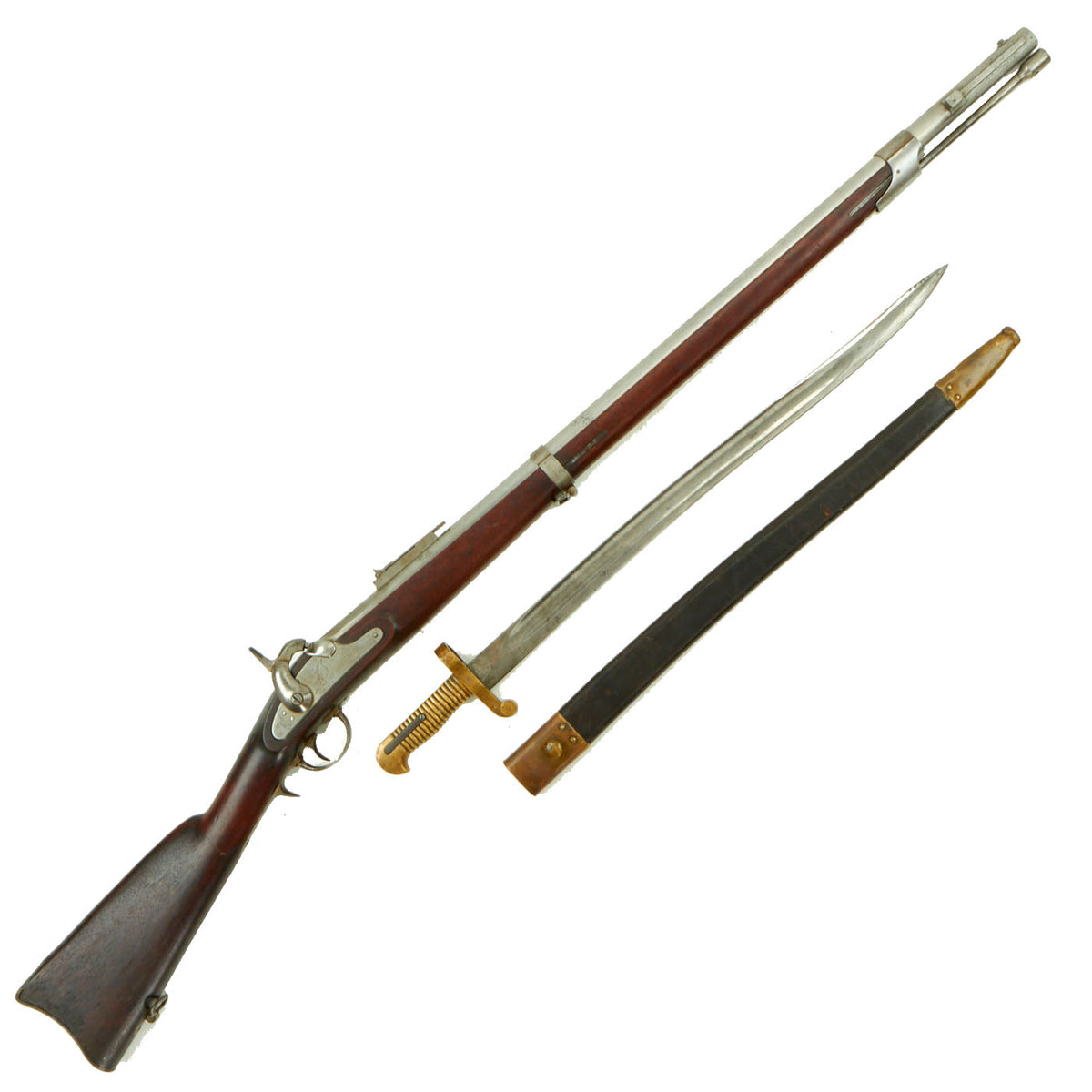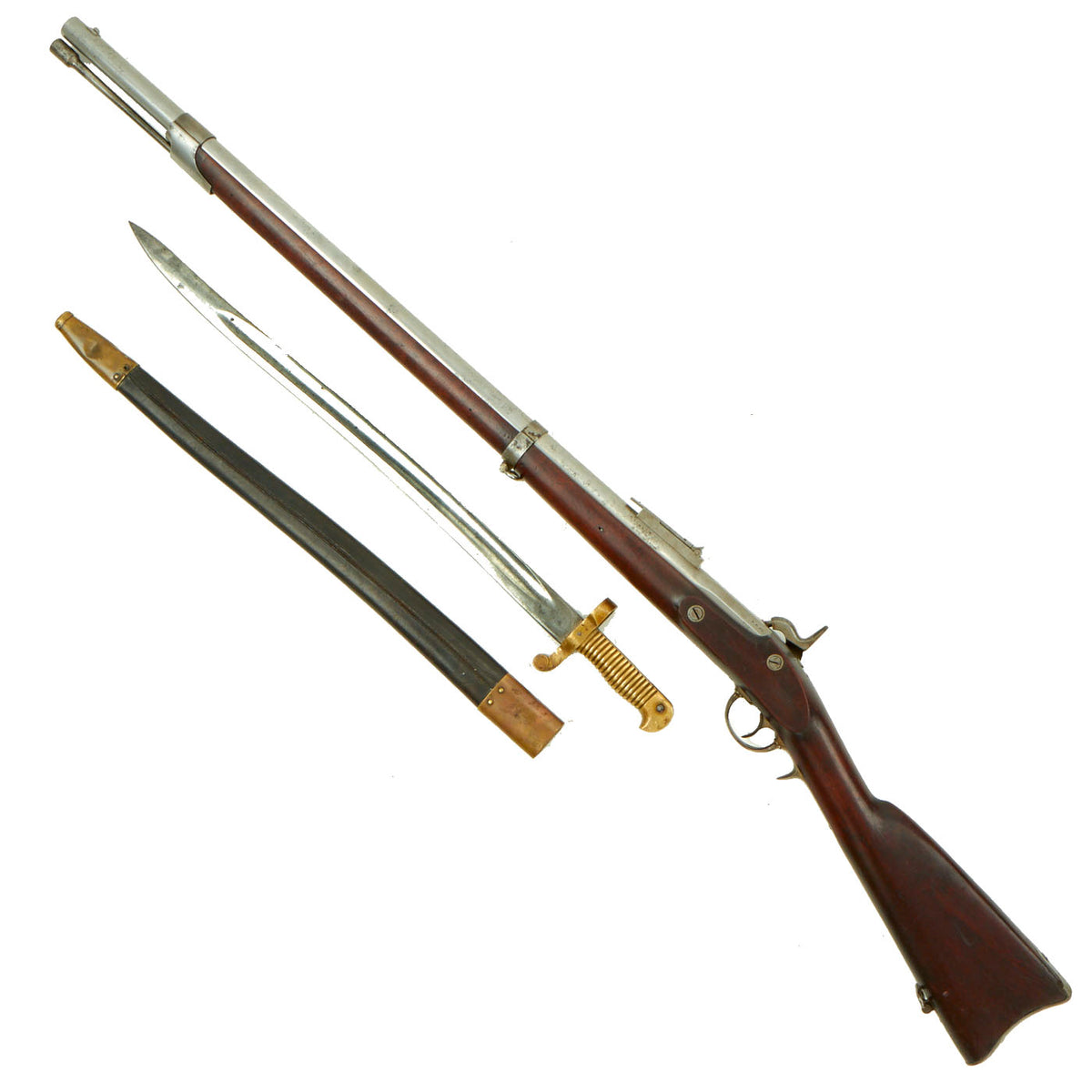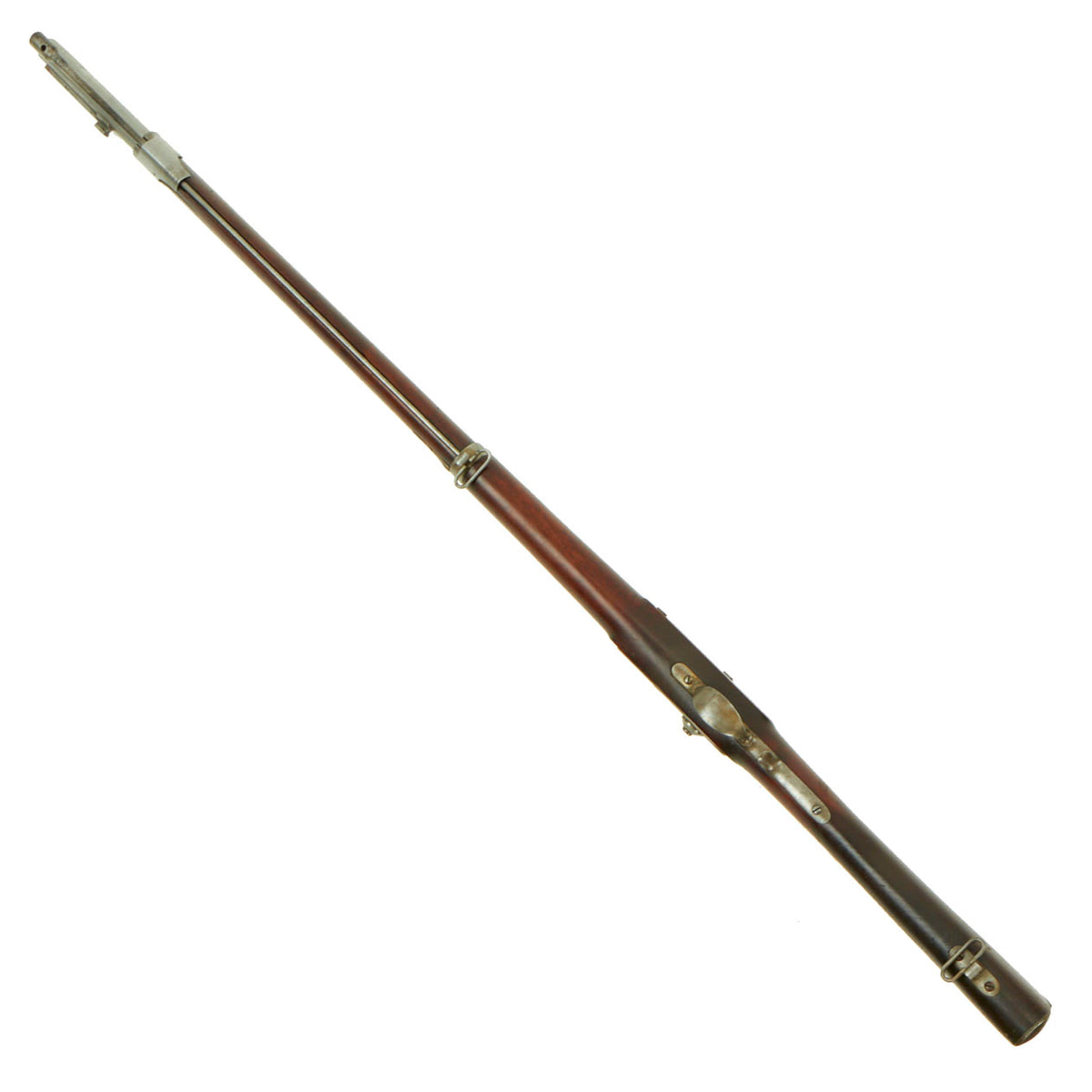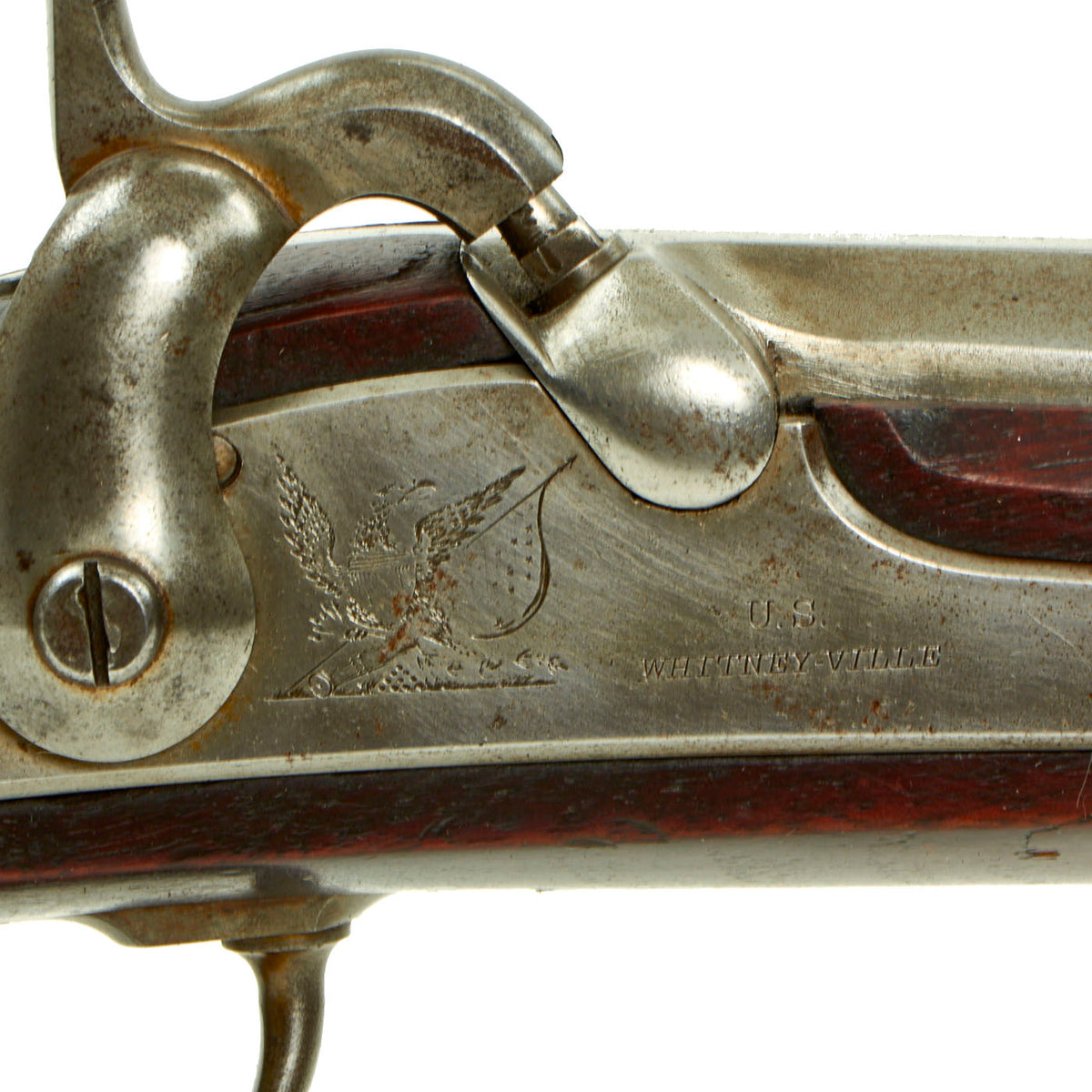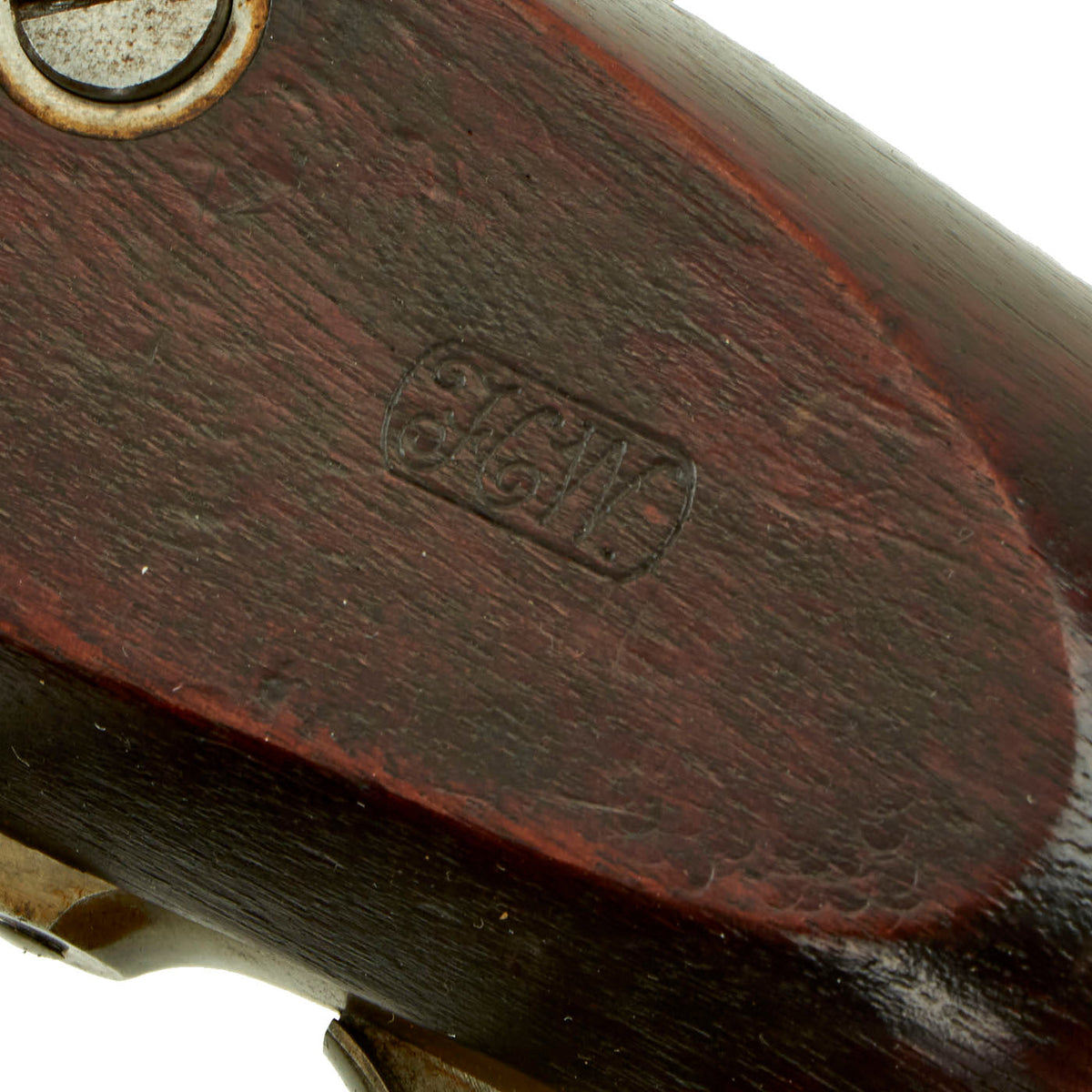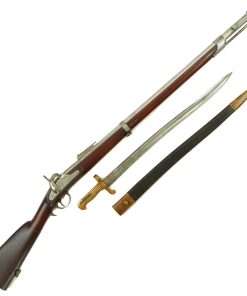Original Excellent U.S. Civil War Whitneyville “Plymouth” Navy Percussion Rifle Serial 5126 with Bayonet & Scabbard – dated 1863 Original Items
$ 4.995,00 $ 1.248,75
Original Item: Only One Available. This is a fantastic offering that we have never had before, and most likely will not see again for some time, if ever! Here we have an Excellent condition rare U.S. Civil War “Plymouth” Navy Percussion Rifle, complete with the even rarer bayonet in its original scabbard. This is one of 10,000 made by Eli Whitney’s manufactory, Whitney-ville, based on an 1861 contract to the U.S. Navy. Five sample rifles were delivered in October 1862 and regular deliveries started in February 1863, with 5,300 delivered that year and the remaining 4,695 in 1864.
The Whitneyville “Plymouth” Navy Rifle was the brainchild of John A. Dahlgren, who began testing the idea of a .69 caliber rifle for the U.S. Navy on the 1858 voyage of the USS Plymouth, hence one of the several names applied to this rifle. Dahlgren wanted a large-caliber short rifle for shipboard use and used the French carabine-a-tige as a model. He wanted a heavy barrel to compensate for its recoil and originally had the idea of fitting it with a Bowie-knife style bayonet that would be useful has a hand-held weapon and for other shipboard tasks. A few of these were made, but it was decided that a longer Saber bayonet would be more practical.
As produced by Whitney for the Navy on a July 1861 contract, the rifle was lighter than Dahlgren envisioned and utilized a saber bayonet supplied by Collins, but mounted a 34-inch .69 caliber rifled barrel secured by two bands, with a long French style rear sight graduated to 1,000 yards. This example matches the pattern exactly, was produced about half way through production, delivered at the very end of 1863.
It is dated 1863 on the lock plate tail, and has the correct Federal Eagle with a U.S. banner to the right. Under the bolster is a U.S. / WHITNEY-VILLE stamping, indicating Whitney production. The barrel nocks form still has complete clear markings, with a date of 1863 on the top and serial number 5126 stamped onto the barrel tang. The left barrel facet is stamped with the standard V / P / Eagle’s Head proof marks, and under this are the initials of the ordnance sub inspector, F.C.W.. This is the marking for civilian inspector Frank C. Warner, who is listed as inspecting Remington M1866 .50RF Pistols, Whitney .36 Percussion Revolvers, Plymouth Rifles, and M1867 Remington Navy Carbines. There is also a CLEAR FCW boxed cartouche on the left side of the stock. The barrel band is still correctly “U” Marked, and the butt plate tang has a U.S. marking on it.
The condition is astounding for being on a rifle over 150 years old, and we suspect it may have never been issued, with all wear being from storage. The metalwork is still mostly in the original polished bright steel state, with a bit of past peppering that has been polished away. The stock is as close to unissued as we have seen on a U.S. service rifle from this era, with a lovely red brown color, and just a few scrapes and dings. The raised grain can still be seen from the original factory finish.
The barrel band and nose cap are both firmly secured with their original retaining springs. Sling swivels are original to the gun, and still move freely, as intended. Under the barrel is the correct characteristic ramrod for this rifle, with the large barrel-shaped end. The original 1000 Yard rear ladder sight is still fitted in place, with all parts intact and fully functional. The lock functions correctly, holding at full cock and dry firing correctly. We checked the bore, and it is in excellent nearly unissued condition, clearly showing three groove rifling, which is crisp. The original cutting marks are still present, and we have not seen a Civil War gun with a better bore in some time, if we have at all.
The included bayonet is also in great shape, with the bright steel ‘Yataghan’ shaped blade only showing a bit of light staining. The hilt is marked with serial number 7611 next to the channel. It has never been sharpened, and still has a clear makers mark on the ricasso:
COLLINS & CO
HARTFORD
CONN.
It comes complete with the original brass-fitted leather scabbard, which has passed the test of time with flying colors. The leather shows some cracking in the finish, but no bends or breaks, and the stitching looks to be complete. The only real issues to note with the scabbard are dents on the drag, and one of the four rivets holding it on is missing. It fits on the rifle easily, locking in place, and can be removed easily as well.
An amazing really important U.S. Civil War Whitney-ville Contract Percussion NAVY Rifle complete with bayonet in wonderful condition. Ready to display!
Specifications (rifle):-
Year of Manufacture: 1863
Caliber: .69″
Cartridge Type: Minié Ball and Powder
Barrel Length: 34 Inches
Overall Length: 50 Inches
Action type: Side Action Lock
Feed System: Muzzle Loaded
Specifications (Bayonet):-
Blade Length: 22 1/2″
Blade Style: Single Edge Yataghan w/ Fuller
Overall length: 27 3/8“
Crossguard: 3 1/2”
Scabbard Length: 24″
John A. Dahlgren
John Adolphus Bernard Dahlgren (November 13, 1809 – July 12, 1870) was a United States Navy officer who founded his service’s Ordnance Department and launched significant advances in gunnery. Dahlgren devised a smoothbore howitzer, adaptable for many sizes of craft and shore installations. He then introduced a cast-iron muzzle-loading cannon with vastly increased range and accuracy, known as the Dahlgren gun, that became the U.S. Navy’s standard armament.
In the Civil War, Dahlgren was made commander of the Washington Navy Yard, where he established the Bureau of Ordnance. In 1863, he took command of the South Atlantic Blockading Squadron at the rank of rear admiral. He helped William Tecumseh Sherman secure Savannah, Georgia.
More on Eli Whitney and the Whitney-ville Armory:
The musket was a product of Eli Whitney’s firm which he called the “Whitneyville-Armory”. A production facility founded in Connecticut circa 1850-70. From a modest factory complex straddling the Mill River just North of New Haven, Connecticut, the Whitney Armory produced more long-arms prior to and during the Civil War than any other private domestic manufacturer. From available records, it appears that the Whitney Armory turned out approximately 141,620 shoulder arms between 1826 and 1865. Furthermore, the variety of arms made was unsurpassed, even when compared to the National Armories. Most if not all of the Whitney long arms of this period found their way into the hands of Union and Confederate soldiers.
From the first government contract in 1798 through the Civil War, Whitney Armory had a steady flow of government work. Between 1826 and 1839, they made 39,000 M1816/22 flintlock muskets, most of which were subsequently converted to percussion. In addition, at least 2,000 more were made directly under state contracts. When the 1841 US Rifle was adopted, Whitney, then under the leadership of Eli Whitney, Jr., received orders totaling 26,500, between 1843 and 1855. They made another 600 with M1855 long-range sights and 420 more for Ohio using parts left over from the US contracts.
Ever creative and practical, Whitney was a master at taking parts discarded by others and incorporating them into serviceable weapons. With the advent of the Civil War, and during the months leading up to the conflict, several unusual models of long arms were made using parts from other sources, such as the US Armory at Springfield and the defunct Robbins and Lawrence operation in Windsor, Vermont. One model closely resembled the US M1855 Rifle-musket, using M1855 lock-plates from Springfield. Only 350 were made and all appear to have been sold to the State of Connecticut around 1861. Around this time, Whitney also made a completely different model which strongly resembled the P53 British Enfield Rifle-musket. This unique arm was made largely from surplus P53 Enfield parts left over from Robbins and Lawrence’s failed Crimean War contract with British government. It is estimated that 3,500 were made and sold to State governments, with 2,000 going to Maryland, 1,225 going to Georgia and 75 to Mississippi in the months just prior to the war. Other arms made in small quantities during this time included 750 Enfield style two-band rifles and 100 M1855 US style two-band rifles. Despite his New England blue-blood roots, Eli Whitney, Jr. apparently had no qualms about selling arms to Southern states on the eve of the Civil War. Of course, in fairness, the Southern states were still part of the Union at the time, so there was no legal reason to deny them arms.
Once the war commenced in earnest, Whitney dedicated almost all of its arms production to the manufacture of arms for the Federal Government and the State of Connecticut. Although Whitney was awarded a contract to make 40,000 US M1861 Rifle-muskets in 1861, he instead chose to proceed with his Connecticut contracts and the M1861 US Navy Plymouth Rifle. In late 1861, the State of Connecticut, taking advantage of its resident gun-maker, bought 6,000 rifle-muskets closely following the M1861 pattern, but not quite to Government specs. In 1862, Connecticut purchased an additional 8,000 rifle-muskets. In addition about 200 rifle-muskets with “humpback” locks, but conforming in all other ways to the Connecticut contracts, and probably bought by Connecticut, were made around this time. Around 1863, Whitney also made approximately 1,200 to 2,000 M1861 Rifle-muskets with extra parts from the Connecticut contract guns and marked them with the name “Manton,” an English gunmaker. Like the Connecticut guns, these Manton rifle-muskets did not meet government specifications, but were serviceable arms.
Whitney’s major federal efforts early in the war were directed at the manufacture of the new Plymouth Rifle. After a slow start, Whitney was able to fill the entire contract of 10,000 stands between 1861 and 1864. With the Plymouth contract nearing completion, Whitney agreed to manufacture M1861 US Rifle-muskets for the Federal government. With machinery and gauges in place, this was done quickly and all were delivered in 1863 and 1864. Unlike the Connecticut contract guns, these all met the strict Federal specifications.
NOTE: International orders of antique firearms MUST be shipped using UPS WW Services (courier). USPS Priority Mail international will not accept these. International customers should always consult their country’s antique gun laws prior to ordering.
Fast Shipping with Professional Packaging
Thanks to our longstanding association with UPS FedEx DHL, and other major international carriers, we are able to provide a range of shipping options. Our warehouse staff is expertly trained and will wrap your products according to our exact and precise specifications. Prior to shipping, your goods will be thoroughly examined and securely secured. We ship to thousands clients each day across multiple countries. This shows how we're dedicated to be the largest retailer on the internet. Warehouses and distribution centres can be located throughout Europe as well as the USA.
Note: Orders with more than one item will be assigned a processing date depending on the item.
Before shipping before shipping, we'll conduct a thorough inspection of the items you have ordered. Today, the majority of orders will be delivered within 48 hours. The delivery time will be between 3-7 days.
Returns
The stock is dynamic and we cannot completely manage it because multiple stakeholders are involved, including our factory and warehouse. So the actual stock may alter at any time. It's possible that you may not receive your order once the order has been made.
Our policy is valid for a period of 30 days. If you don't receive the product within 30 days, we are not able to issue a refund or an exchange.
You can only return an item if it is unused and in the same state as the day you received it. You must have the item in its original packaging.
Related products
Uncategorized
Uncategorized
Uncategorized
Armoured Fighting Vehicles of the World: AFVs of World War One (Hardcover Book) New Made Items
Uncategorized
Uncategorized
Uncategorized
Uncategorized
Uncategorized
Uncategorized
Angolan Rebel 1970s era 60mm Inert Display Mortar from Angolan Civil War Original Items
Uncategorized
Uncategorized
Uncategorized
Uncategorized
Uncategorized
Uncategorized
Armored Burgonet Helmet & Polearm from Scottish Castle Leith Hall Circa 1700 Original Items
Uncategorized
Uncategorized
Uncategorized
